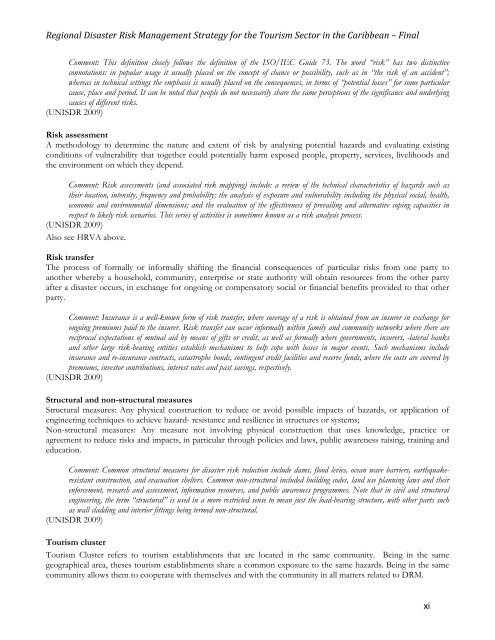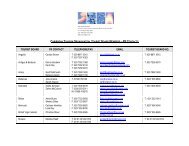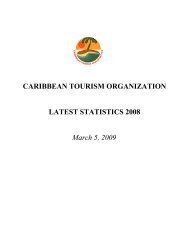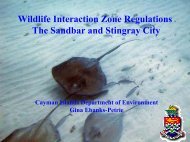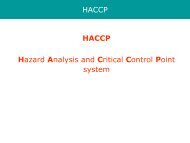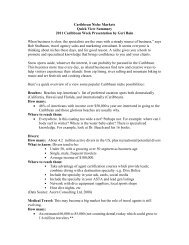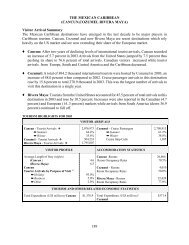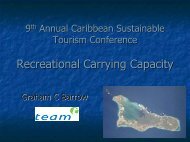Disaster Risk Management Strategy and Plan of Action - Caribbean ...
Disaster Risk Management Strategy and Plan of Action - Caribbean ...
Disaster Risk Management Strategy and Plan of Action - Caribbean ...
You also want an ePaper? Increase the reach of your titles
YUMPU automatically turns print PDFs into web optimized ePapers that Google loves.
Regional <strong>Disaster</strong> <strong>Risk</strong> <strong>Management</strong> <strong>Strategy</strong> for the Tourism Sector in the <strong>Caribbean</strong> – Final<br />
Comment: This definition closely follows the definition <strong>of</strong> the ISO/IEC Guide 73. The word “risk” has two distinctive<br />
connotations: in popular usage it usually placed on the concept <strong>of</strong> chance or possibility, such as in “the risk <strong>of</strong> an accident”;<br />
whereas in technical settings the emphasis is usually placed on the consequences, in terms <strong>of</strong> “potential losses” for some particular<br />
cause, place <strong>and</strong> period. It can be noted that people do not necessarily share the same perceptions <strong>of</strong> the significance <strong>and</strong> underlying<br />
causes <strong>of</strong> different risks.<br />
(UNISDR 2009)<br />
<strong>Risk</strong> assessment<br />
A methodology to determine the nature <strong>and</strong> extent <strong>of</strong> risk by analysing potential hazards <strong>and</strong> evaluating existing<br />
conditions <strong>of</strong> vulnerability that together could potentially harm exposed people, property, services, livelihoods <strong>and</strong><br />
the environment on which they depend.<br />
Comment: <strong>Risk</strong> assessments (<strong>and</strong> associated risk mapping) include: a review <strong>of</strong> the technical characteristics <strong>of</strong> hazards such as<br />
their location, intensity, frequency <strong>and</strong> probability; the analysis <strong>of</strong> exposure <strong>and</strong> vulnerability including the physical social, health,<br />
economic <strong>and</strong> environmental dimensions; <strong>and</strong> the evaluation <strong>of</strong> the effectiveness <strong>of</strong> prevailing <strong>and</strong> alternative coping capacities in<br />
respect to likely risk scenarios. This series <strong>of</strong> activities is sometimes known as a risk analysis process.<br />
(UNISDR 2009)<br />
Also see HRVA above.<br />
<strong>Risk</strong> transfer<br />
The process <strong>of</strong> formally or informally shifting the financial consequences <strong>of</strong> particular risks from one party to<br />
another whereby a household, community, enterprise or state authority will obtain resources from the other party<br />
after a disaster occurs, in exchange for ongoing or compensatory social or financial benefits provided to that other<br />
party.<br />
Comment: Insurance is a well-known form <strong>of</strong> risk transfer, where coverage <strong>of</strong> a risk is obtained from an insurer in exchange for<br />
ongoing premiums paid to the insurer. <strong>Risk</strong> transfer can occur informally within family <strong>and</strong> community networks where there are<br />
reciprocal expectations <strong>of</strong> mutual aid by means <strong>of</strong> gifts or credit, as well as formally where governments, insurers, -lateral banks<br />
<strong>and</strong> other large risk-bearing entities establish mechanisms to help cope with losses in major events. Such mechanisms include<br />
insurance <strong>and</strong> re-insurance contracts, catastrophe bonds, contingent credit facilities <strong>and</strong> reserve funds, where the costs are covered by<br />
premiums, investor contributions, interest rates <strong>and</strong> past savings, respectively.<br />
(UNISDR 2009)<br />
Structural <strong>and</strong> non-structural measures<br />
Structural measures: Any physical construction to reduce or avoid possible impacts <strong>of</strong> hazards, or application <strong>of</strong><br />
engineering techniques to achieve hazard- resistance <strong>and</strong> resilience in structures or systems;<br />
Non-structural measures: Any measure not involving physical construction that uses knowledge, practice or<br />
agreement to reduce risks <strong>and</strong> impacts, in particular through policies <strong>and</strong> laws, public awareness raising, training <strong>and</strong><br />
education.<br />
Comment: Common structural measures for disaster risk reduction include dams, flood levies, ocean wave barriers, earthquakeresistant<br />
construction, <strong>and</strong> evacuation shelters. Common non-structural included building codes, l<strong>and</strong> use planning laws <strong>and</strong> their<br />
enforcement, research <strong>and</strong> assessment, information resources, <strong>and</strong> public awareness programmes. Note that in civil <strong>and</strong> structural<br />
engineering, the term “structural” is used in a more restricted sense to mean just the load-bearing structure, with other parts such<br />
as wall cladding <strong>and</strong> interior fittings being termed non-structural.<br />
(UNISDR 2009)<br />
Tourism cluster<br />
Tourism Cluster refers to tourism establishments that are located in the same community. Being in the same<br />
geographical area, theses tourism establishments share a common exposure to the same hazards. Being in the same<br />
community allows them to cooperate with themselves <strong>and</strong> with the community in all matters related to DRM.<br />
xi


